|
|
|

![]()
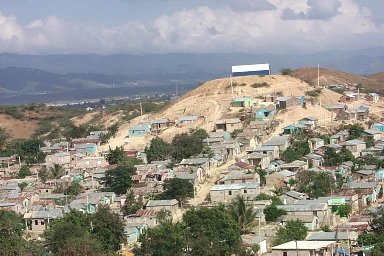
The barrio of Cienfuegos is located on the northwestern edge of Santiago. Those who live in the DR's barrios are often former campo residents, or campesinos, who have moved to the city looking for a job and a better life. On the positive side, the campo's strong sense of community and hospitality tend to transfer to the barrio; on the negative side, housing is poor, and the jobs that residents get rarely pay enough to cover living expenses.
In 1975, one of Santiago's barrios experienced a major fire, burning 100 families out of their homes. These families moved to the outskirts of Santiago, and established Cienfuegos: the name refers to the "100 Fires" of the disaster. The people of Cienfuegos are by their own admission essentially squatters on their land; they do not own the land on which their homes sit, and yet the city allows them to remain there. However, because they are squatters, the city has often been reluctant to respond to the residents' needs. When crime became a problem in Cienfuegos, the police were deaf to the residents' pleas for help until the latter threatened to take action against the hoodlums themselves. And then there's the city dump.
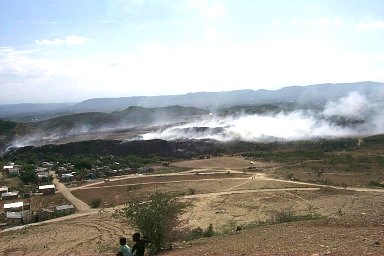
Cienfuegos is adjacent to Santiago's enormous dump. That's it smoldering near the center of the picture. A few years ago, something in the dump caught fire, and it has been slowly burning ever since. The winds normally blow in a northerly direction, but sometimes it shifts, and goes in the direction of the barrio. It always smells bad in Cienfuegos; one always feels grimy after being there. Respiratory ailments are common among the residents, as well as gastric problems.
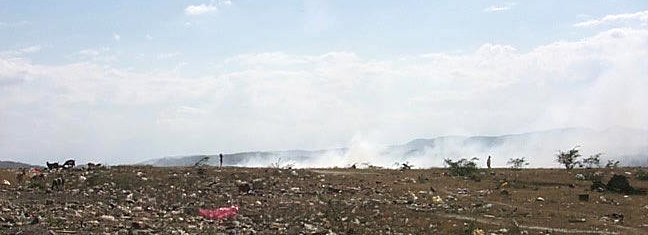
People graze their goats and pigs near the dump. There are few regulations in the DR about the disposal of hazardous and medical waste; they all go into the dump. Tomas, whom we'll meet in Sarah Jones' report, refuses to go near the dump since the day that he saw a pig there munching on a human leg.
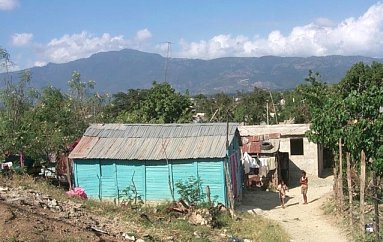
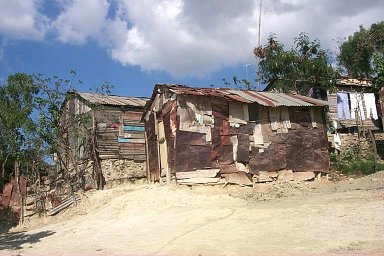
The oldest houses of Cienfuegos are constructed from clapboard or scraps of tin, as seen above.
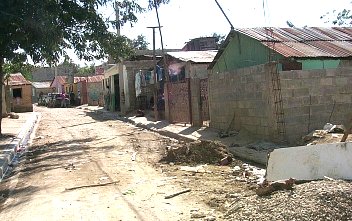
The principal road going into Cienfuegos was paved a few years ago in anticipation of Castro's visit; it seems that he is from the Cienfuegos region in Cuba, so the government wanted to impress him. Once in the barrio, however, the roads are like this one above, a dirt road filled with debris. It is not uncommon for people from Santiago to drive in and dump their trash out on the residential streets of Cienfuegos. After all, what are those squatters going to do to stop them?
Many residents of Cienfuegos work in the sweatshops of the nearby Zona Franca, the Free Trade Zone. The pay is shockingly low -- around US $1.40 per hour for one of the "better" manufacturers before deductions for what benefits workers may get. Cienfuegos families therefore often have to pool their resources with other families to survive. This is where the strong sense of community fostered by the barrio's origins become most evident.
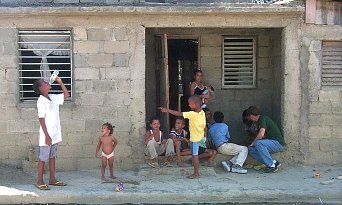
Because both parents need to work to try to make ends meet, the children are left to fend for themselves for a good part of the day. Neighbors make it a point to watch over the children when their parents are absent. Here Pat is playing jacks with a group of young girls on their porch, while the eldest sister cares for the baby.
As we have found everywhere in the DR, in spite of the poverty and struggling we witness, there is abundant evidence of love and even joy in Cienfuegos. Sarah Jones will tell us of her experiences in this barrio in her report.
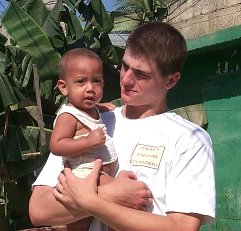
Adam makes a new friend in Cienfuegos. (Hey Adam, nice haircut!)
![]()